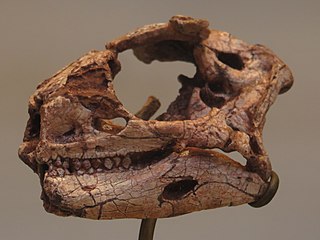
Lesothosaurus is a monospecific genus of ornithischian dinosaur that lived during the Early Jurassic in what is now South Africa and Lesotho. It was named by paleontologist Peter Galton in 1978, the name meaning "lizard from Lesotho". The genus has only one valid species, Lesothosaurus diagnosticus. Lesothosaurus is one of the most completely-known early ornithischians, based on numerous skull and postcranial fossils from the Upper Elliot Formation. It had a simpler tooth and jaw anatomy than later ornithischians, and may have been omnivorous in some parts of the year.

Melanorosaurus is a genus of basal sauropodomorph dinosaur that lived during the Late Triassic period. A herbivore from South Africa, it had a large body and sturdy limbs, suggesting it moved about on all fours. Its limb bones were massive and heavy like the limb bones of true sauropods.

Massospondylus is a genus of sauropodomorph dinosaur from the Early Jurassic. It was described by Sir Richard Owen in 1854 from remains discovered in South Africa, and is thus one of the first dinosaurs to have been named. Fossils have since been found at other locations in South Africa, Lesotho, and Zimbabwe. Material from Arizona's Kayenta Formation, India, and Argentina has been assigned to the genus at various times, but the Arizonan and Argentinian material are now assigned to other genera.

Lufengosaurus is a genus of massospondylid dinosaur which lived during the Early Jurassic period in what is now southwestern China.
Blikanasaurus is a genus of sauropodomorph dinosaur from the late Triassic of South Africa. The generic name Blikanasaurus is derived from Greek, meaning "lizard from Blikana". The species name cromptoni is taken from the surname of A.W. “Fuzz” Crompton, an American paleontologist who led numerous field expeditions in Elliot Formation outcrop localities in South Africa. Blikanasaurus is only known from partial hindlimb bones that were recovered from the lower Elliot Formation (LEF) in the Eastern Cape.
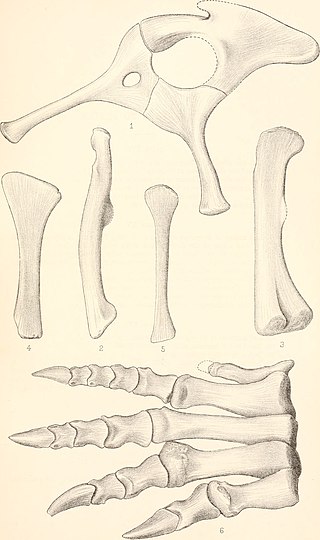
Gryponyx is an extinct genus of massopod sauropodomorph known from southern Free State, central South Africa.

Gyposaurus is a genus of basal sauropodomorph dinosaur from the early Jurassic of South Africa. It is usually considered to represent juveniles of other prosauropods, but "G." sinensis is regarded as a possibly valid species.

Hortalotarsus is a dubious genus of extinct sauropodomorph from the Early Jurassic (Sinemurian-aged) Clarens Formation of Eagle's Crag, South Africa.

The Clarens Formation is a geological formation found in several localities in Lesotho and in the Free State, KwaZulu-Natal, and Eastern Cape provinces in South Africa. It is the uppermost of the three formations found in the Stormberg Group of the greater Karoo Supergroup rocks and represents the final phase of preserved sedimentation of the Karoo Basin.
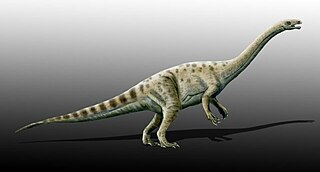
Massospondylidae is a family of early massopod dinosaurs that existed in Asia, Africa, North America, South America and Antarctica during the Late Triassic to the Early Jurassic periods. Several dinosaurs have been classified as massospondylids over the years. The largest cladistic analysis of early sauropodomorphs, which was presented by Apaldetti and colleagues in November 2011, found Adeopapposaurus, Coloradisaurus, Glacialisaurus, Massospondylus, Leyesaurus and Lufengosaurus to be massospondylids. This result supports many previous analyses that tested fewer taxa. However, this analysis found the two recently described North American massopods, Sarahsaurus and Seitaad, and the South African Ignavusaurus to nest outside Massospondylidae, as opposed to some provisional proposals. Earlier in 2011, Pradhania, a sauropodomorph from India, was tested for the first time in a large cladistic analysis and was found to be a relatively basal massospondylid. Mussaurus and Xixiposaurus may also be included within Massospondylidae. In 2019, a specimen previously assigned to Massospondylus from South Africa was re-examined and found to belong to a separate genus that was named Ngwevu.
The Bushveld Sandstone is a geological formation dating to roughly between 201 and 189 million years ago and covering the Carnian to Norian stages. The Bushveld Sandstone is found in Transvaal, South Africa and is a member of the Stormberg Group. As its name suggests, it consists mainly of sandstone. Fossils of the prosauropod dinosaur Massospondylus have been recovered from the Bushveld Sandstone.

Plateosauria is a clade of sauropodomorph dinosaurs which lived during the Late Triassic to the Late Cretaceous. The name Plateosauria was first coined by Gustav Tornier in 1913. The name afterwards fell out of use until the 1980s.

The Elliot Formation is a geological formation and forms part of the Stormberg Group, the uppermost geological group that comprises the greater Karoo Supergroup. Outcrops of the Elliot Formation have been found in the northern Eastern Cape, southern Free State, and in the eastern KwaZulu-Natal provinces of South Africa. Outcrops and exposures are also found in several localities in Lesotho such as Qacha's Neck, Hill Top, Quthing, and near the capital, Maseru. The Elliot Formation is further divided into the lower (LEF) and upper (UEF) Elliot formations to differentiate significant sedimentological differences between these layers. The LEF is dominantly Late Triassic (Norian-Hettangian) in age while the UEF is mainly Early Jurassic (Sinemurian-Pliensbachian) and is tentatively regarded to preserve a continental record of the Triassic-Jurassic boundary in southern Africa. This geological formation is named after the town of Elliot in the Eastern Cape, and its stratotype locality is located on the Barkly Pass, 9 km north of the town.
Ignavusaurus is a genus of basal sauropodomorph dinosaur that lived during the Early Jurassic in what is now Lesotho. Its fossils were found in the Upper Elliot Formation which is probably Hettangian in age. It was described on the basis of a partial, well preserved articulated skeleton. The type species, I. rachelis, was described in 2010 by Spanish palaeontologist F. Knoll.

The Stormberg Group is one of the four geological groups that comprises the Karoo Supergroup in South Africa. It is the uppermost geological group representing the final phase of preserved sedimentation of the Karoo Basin. The Stormberg Group rocks are considered to range between Lower Triassic (Olenekian) to Lower Jurassic (Pliensbachian) in age. These estimates are based on means of geological dating including stratigraphic position, lithostratigraphic and biostratigraphic correlations, and palynological analyses.
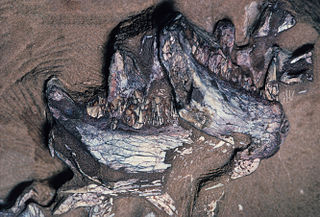
Pegomastax is a genus of heterodontosaurid dinosaur that lived during the Early Jurassic of South Africa. The only known specimen was discovered in a 1966-1967 expedition in Transkei District of Cape Province, but wasn't described until 2012 when Paul Sereno named it as the new taxon Pegomastax africana. The genus name is derived from the Greek for "strong jaw", and the species name describes the provenance of Africa; it was originally spelled africanus, was corrected to africana to align with the gender of the genus name.
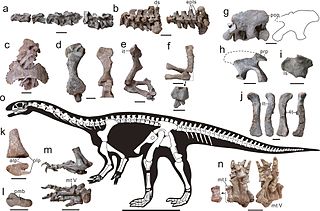
Xingxiulong is a genus of bipedal sauropodiform from the Early Jurassic of China. It contains a single species, X. chengi, described by Wang et al. in 2017 from three specimens, two adults and an immature individual, that collectively constitute a mostly complete skeleton. Adults of the genus measured 4–5 metres (13–16 ft) long and 1–1.5 metres tall. Phylogenetic analysis suggests that Xingxiulong is most closely related to its contemporary Jingshanosaurus, although an alternative position outside of both the Sauropodiformes and Massospondylidae is also plausible.

Pentasaurus is an extinct genus of dicynodont of the family Stahleckeriidae, closely related to the well known Placerias. It was found in the Lower Elliot Formation of South Africa, dated to the Norian of the Late Triassic period. The genus contains the type and only species, Pentasaurus goggai. Pentasaurus is named after the ichnogenus Pentasauropus, fossil footprints that were originally described from the lower Elliot Formation in 1970 decades before the body fossils of Pentasaurus itself were recognised. Pentasauropus footprints were likely made by dicynodonts, and in South Africa Pentasaurus itself was the likely trackmaker. The name reflects the fact that a large dicynodont was predicted to have existed in the lower Elliot Formation before any body fossils were recognised, and so Pentasaurus was named after its probable footprints. This is a reversal of the more typical occurrence where fossil footprints are named after their presumed trackmakers. The name of the species honours its collector Alfred Brown, nicknamed "Gogga", which means "bug" in Afrikaans.
Scalenodontoides is an extinct genus of Traversodontidae, a family of herbivorous cynodonts. It lived during the Late Triassic in what is now South Africa. Its type species is Scalenodontoides macrodontes. It was named in 1957 by A. W. Crompton and F. Ellenberger. Arctotraversodon plemmyrodon was originally classified as a species of Scalenodontoides, but was given its own genus in 1992. It is found in the Scalenodontoides Assemblage Zone of the Elliot Formation, which is named for it. It is one of the geologically youngest traversodontids, alongside the putative traversodontid Boreogomphodon. It is closely related to Exaeretodon and Siriusgnathus, but is distinguished by the presence of a shelf-like expansion of its parietal called the nuchal table. Though the largest known complete skull is only 248 millimetres (9.8 in) long, it may have been the largest non-mammaliaform cynodont, as an incomplete snout would have belonged to a specimen with an estimated skull length of 617 millimetres (24.3 in).


























